 Decades after the end of the war, the majority of Cambodians live in poverty while gaps between rich and poor, and urban and rural areas continue to grow. Cambodia's efforts to address the widespread deprivation and inequality have been largely inadequate. Despite a steady increase in GDP per capita, government expenditure on health and education is comparatively low, raising questions about whether the government is dedicating the maximum available resources to realizing economic, social and cultural rights.
Decades after the end of the war, the majority of Cambodians live in poverty while gaps between rich and poor, and urban and rural areas continue to grow. Cambodia's efforts to address the widespread deprivation and inequality have been largely inadequate. Despite a steady increase in GDP per capita, government expenditure on health and education is comparatively low, raising questions about whether the government is dedicating the maximum available resources to realizing economic, social and cultural rights.
CESR's factsheet on Cambodia provides a graphic overview of selected elements of the human rights to health, food, education, housing and water, seeking to highlight areas where government efforts to realize these rights may be inadequate. It was prepared in light of Cambodia's appearance before the UN Committee on Economic, Social and Cultural Rights (CESCR) in May 2009 and the Universal Periodic Review in December 2009.
The factsheet is part of CESR's Visualizing Rights series. Each factsheet focuses on a country and its economic, social and cultural rights obligations. This focus helps enable intergovernmental human rights mechanisms, such as the UN, and national and international NGOs, monitor governments' compliance with their economic, social and cultural rights obligations.
The latest available socioeconomic data is used, taken either from international sources such as the World Bank or the UNDP, or national sources, such as national statistics bureaus. This data is displayed using graphs and charts, and then analyzed and interpreted. This is intended to shed light on the condition of governments' economic and social rights obligations.
